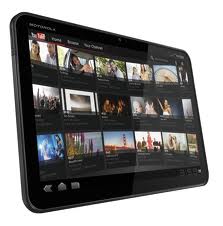The Consumer Electronics Show (CES) for 2011 will be coming to a close in a day or so. For those of you not familiar with CES, it’s the mecca of electronic gear and is the outlet of choice for anybody hoping to announce the next big thing. Cell phones, televisions, video and audio equipment, cars, anything that’s been under development for any length of time will be shown, sometimes in ‘not quite ready for prime time’ form. Apple, smugly, doesn’t participate.

Last year was the year of the iPhone killers being announced. The iPhone, even with the nearly unanimously detested AT&T exclusivity is wounded (by some very cool Android phones and software as well as lack of 4G connectivity) but very much alive. With the impending availability of the iPhone on the better respected Verizon network, the popularity of the iPhone is probably due for a surge upward.
Other than 3D video, the big buzz before the show this year was the upcoming spate of tablet PCs being introduced, almost every one of them launched with the hope of knocking the iPad off it’s perch. I was particularly excited about seeing the new hardware in anticipation of making recommendations for our ZipChart Electronic Medical Records (EMR) clients. So, having a lot (over 80) of tablets and tabletlike hardware to check out was a great thing.
The iPad has some vulnerabilities built in, especially when considering it as a business class tool. The operating system is completely inaccessible without ‘jailbreaking’ and thus voiding any support from Apple. In our case, it means accessing our web-based EMR system within a local network is made significantly more difficult because of the lack of access to a ‘hosts’ file, which would allow us to route internal web traffic to an internal web server without ‘going out over the internet’. The lack of Flash support is a major issue for most people trying to browse the web. Apple also uses an internal Adobe Acrobat reader process that is, compared to a full blown Acrobat Reader or Acrobat product, crippled in a proprietary fashion. We have an app to work around that problem. The virtual keyboard is NOT as good as a physical keyboard. There are other issues, but those are the main ones.
What’s GREAT about the iPad in our particular clinical setting is battery life. As a replacement for a Windows based Tablet PC, it’s marvelous. It is lighter than any tablet we have in the field, all of which require a battery change at least once per day. The other entertainment features and the great App Store are, thus far, unparelleled. The coolness factor can’t be denied, either. The price of a minimum spec iPad (without 3G) also undercuts any comparable Tablet PC.
Out of the pack of tablets announced and/or offered at CES 2011, two stand out as having a shot at dethroning the iPad, at least in the business environment; the BlackBerry PlayBook and the Motorola Xoom. The PlayBook has the advantage of a huge installed base of BlackBerry users in the business environment, but I feel that their proprietary operating system will knock them out of contention, leaving the Motorola Xoom to gain a foothold in the iPad arena.
First and foremost on the 10 inch screen (same as iPad) Xoom list of ‘best of show’ features is the Android Honeycomb OS, developed by Google to be a tablet specific operating system versus a modified cell phone OS. Google some demos and watch some videos, it’s really good stuff.
Hardware-wise, the Xoom is (as of today) head and shoulders over the iPad. GPS on the Xoom, no GPS on the iPad. Front and rear facing cameras on the Xoom, no camera on the iPad. The Xoom has a dual core processor versus a single core for the Ipad. 4G connectivity (when available) and ability to act as a wireless hotspot versus 3G and no hotspot for the iPad. HDMI out for the Xoom versus no HDMI out for the iPad. The weight and battery life are listed as being identical to the iPad, although our personal experience with claims of battery longevity are always suspect until tested in the wild. That said, the iPad 2 is due to be released imminently and all rumors point to nearly ALL of the above hardware shortcomings being resolved. One safe bet, however, is that the software issues will not be totally resolved and the two things that cause us issues with easily implementing iPads into our EMR suite of products (Acrobat functionality and OS accessibility for networking) will not be changed.
We should be able to install Acrobat Reader X on a Xoom to access and share PDF documents within our medical charting system. We will also be able to easily manipulate network settings to route traffic the way we want to on a local network. The only deal killer could be the battery life if a Xoom can’t make it through a day without a battery recharge.
A bet on the Xoom is, perhaps, a bet on Android versus Apple. The success of Google can’t be denied, nor can that of Apple. Where we feel the Xoom advantage lies is within the operating system and the future development of apps for Android. The perennial smugness of Apple, and an argument can be made that they have earned the right to be smug because of their wildly successful and solid products, may come home to roost IF the support for the Xoom (and similar products) is anything like it should be.
Motorola has a shot at it, their track record is a little scary but maybe they will run with this.

One response to “Is the Motorola Xoom the iPad killer?”